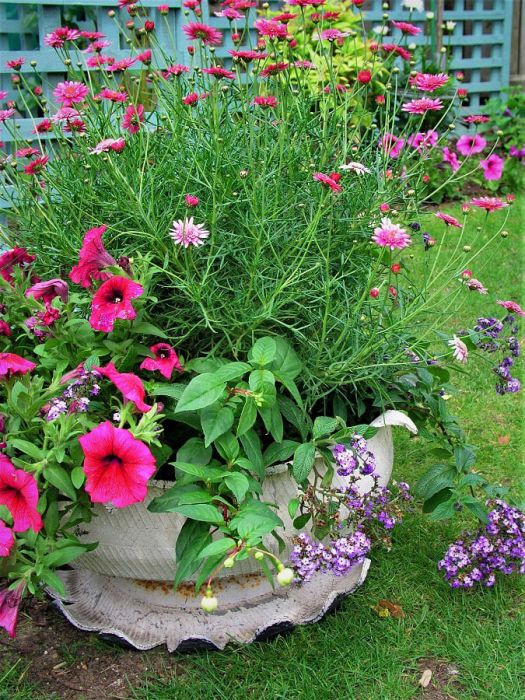
Eudora Welty struck a chord in the 1940’s, when she described women and children fighting over tires off a wrecked car. The children needed swings, but the women wanted them for planters.
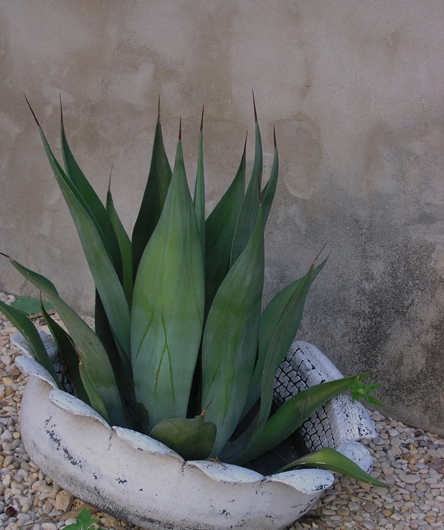

Gardening wisdom and whimsy

Eudora Welty struck a chord in the 1940’s, when she described women and children fighting over tires off a wrecked car. The children needed swings, but the women wanted them for planters.

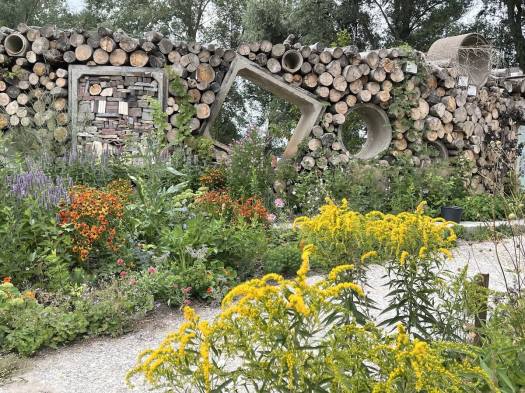
I have a deliberate long, low brash pile alongside a fence that makes cleaning up the garden convenient while saving space at the landfill. And it teems with beneficial wildlife.
And yeah, I wrote brash, which is the actual term for piles of branches, twigs, leaves, weeds, and other garden trimmings. We often call it brush because, well, we repeat words we have always heard, right or wrong. A newly-popular word for this is hügelkultur, or “mound gardening” in which compostable logs, limbs, leaves, and other debris are piled up and decompose into rich soil. Just like in nature, only more orderly.
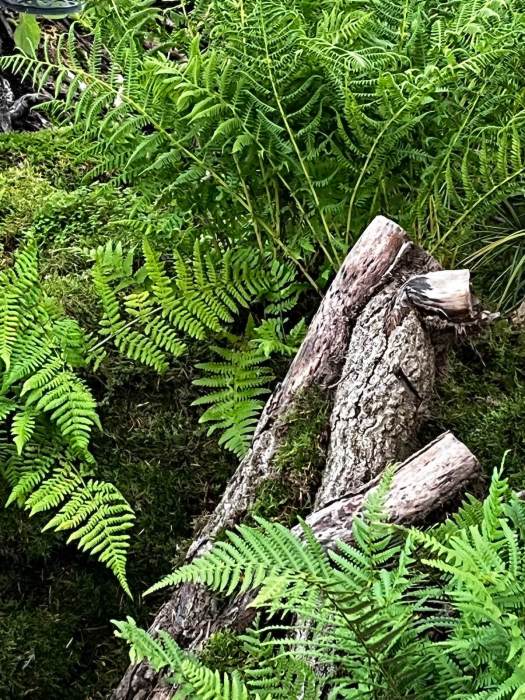
Mine started after an ice storm left a lot of fallen tree debris everywhere, which I dragged alongside a fence and have simply added to over the years. Following the Alice’s Restaurant theme of “one big pile is better than two little piles” it just became the place to toss stuff too large for my usual compost pile.
The long, low feature teems with all sorts of critters, from lightning bugs and other beetles to “roly-poly” pillbugs, slugs, spiders, native solitary bees (the powerhouse pollinators of my garden, which nest in holes they drill into logs), toads, tree frogs, several species of lizards, nesting birds, and so much more – even woods gnomes. And yeah, the occasional beneficial non-venomous snake that keeps things in check (what, you okay with the slugs and mice?). All are as happy as can be, and my garden is richer for them all.
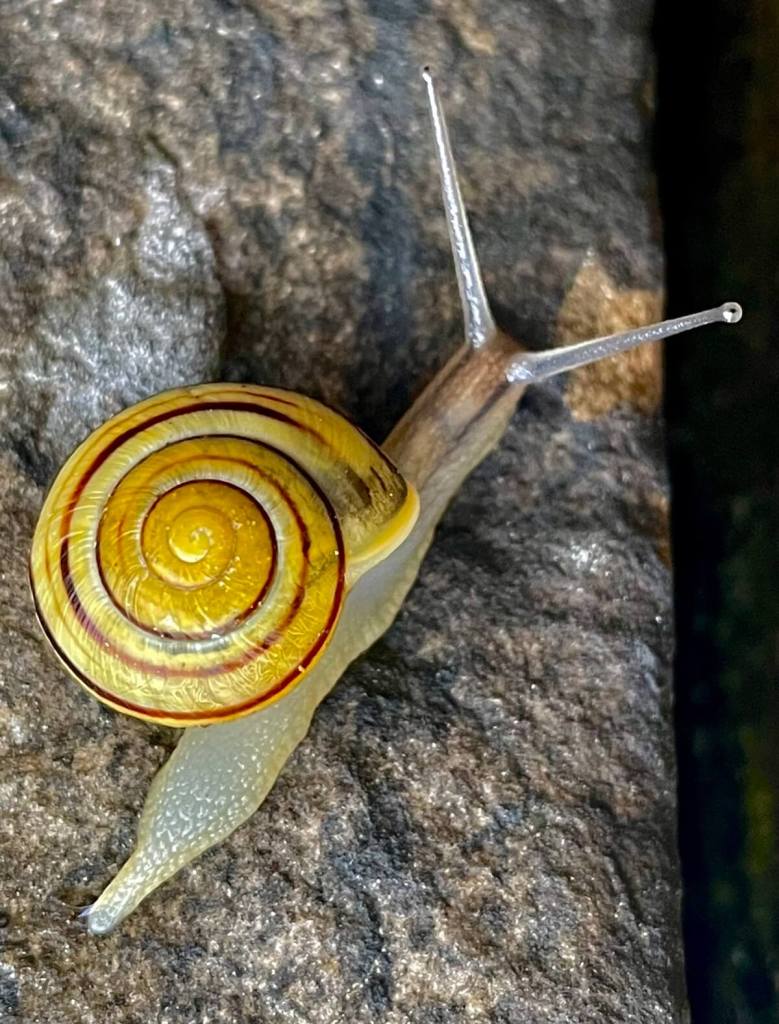


Not to everyone’s liking, I’m sure, but my garden is large enough to accommodate it. And, being a gardener who takes responsibility for my own yard refuse, I’m loath to haul stuff to the curb when it can actually be put to work. As long as it is in one place, it looks fine, and things seem to work out.
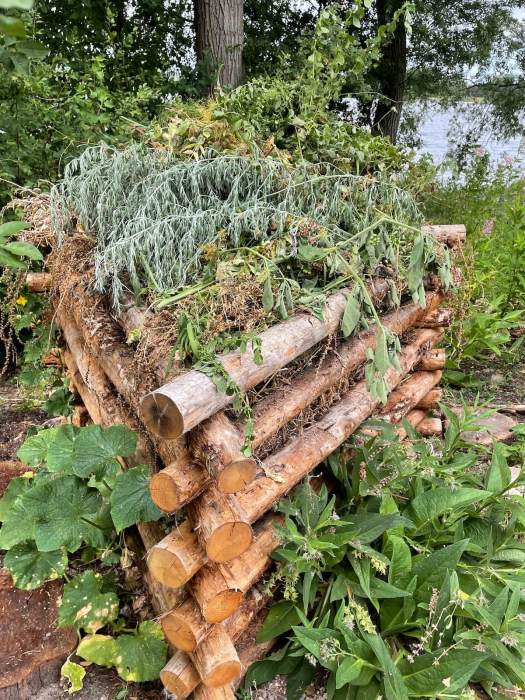
An ancient and common garden construction (and currently one of the most popular themes in Royal Horticulture Society flower shows) is the “dead hedge” – a long, narrow wall made of limbs, long branches, and vines woven between vertical stakes cut from trees or shrubs. Traditionally used as low fences and enclosures, a dead hedge is actually just somewhere between a traditional split rail fence and a more tightly woven wattle.



Maintaining a dead hedge is an ongoing, year-round activity; as I tidy up the garden I drag my tarp of fallen limbs, shrub prunings, or tall weeds and stack/tuck them wherever they fit.
This is also an easy way to accent a shaded garden, especially if you include old stumps and logs for moss, lichens, and fungi to grow on. A rustic bench here, a teepee of limbs there, a stump or two for accent, and this naturalistic theme can add a year-round woodsy touch for any garden. While saving space at the landfill, and making a garden truly wildlife friendly.
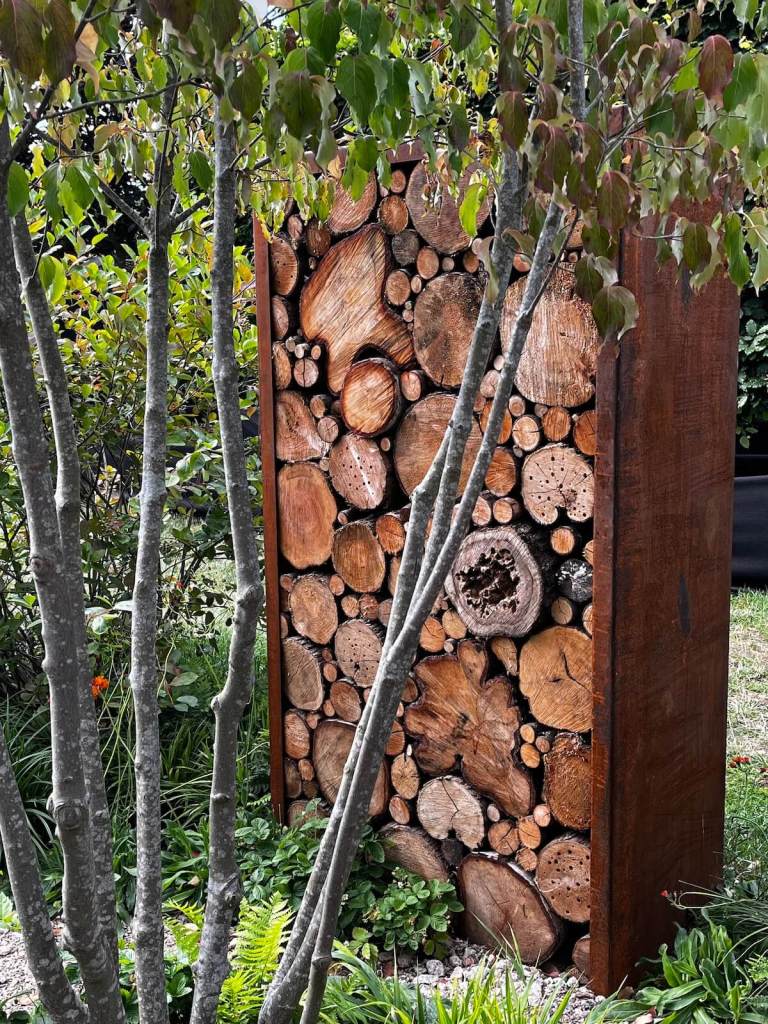


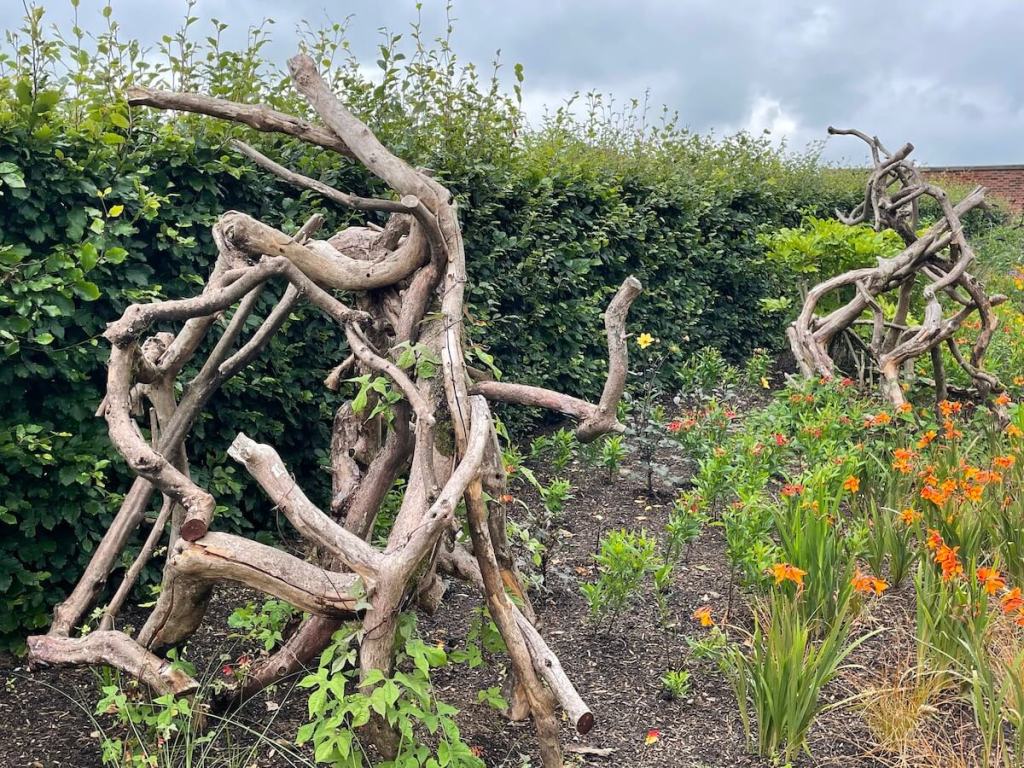
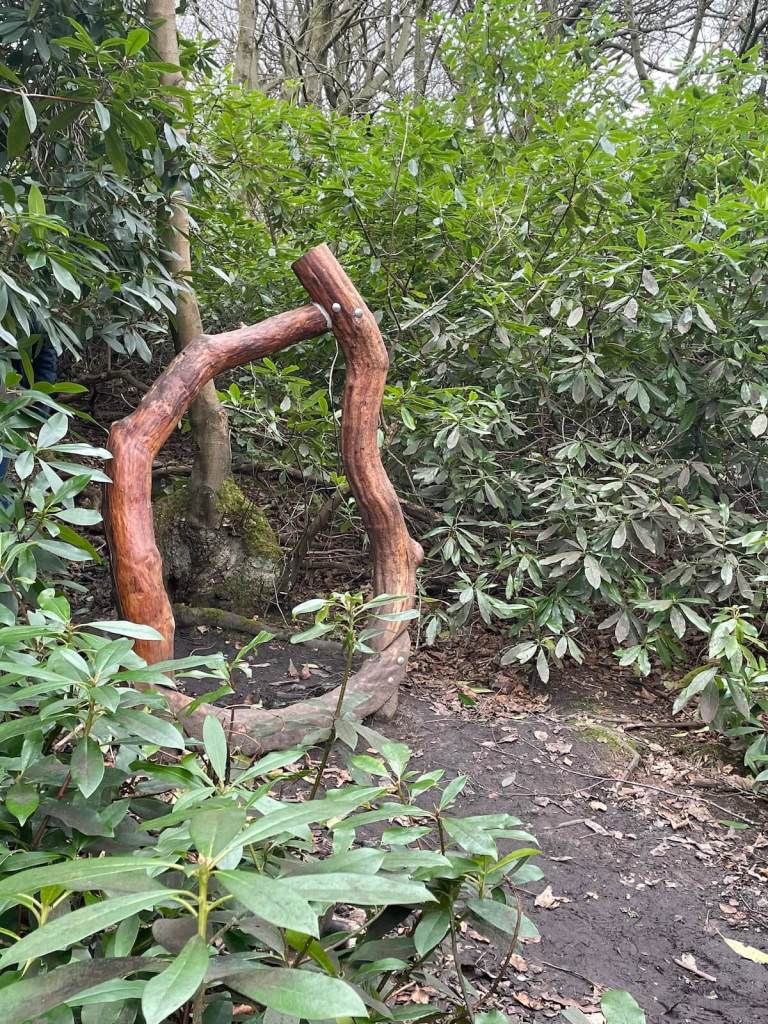
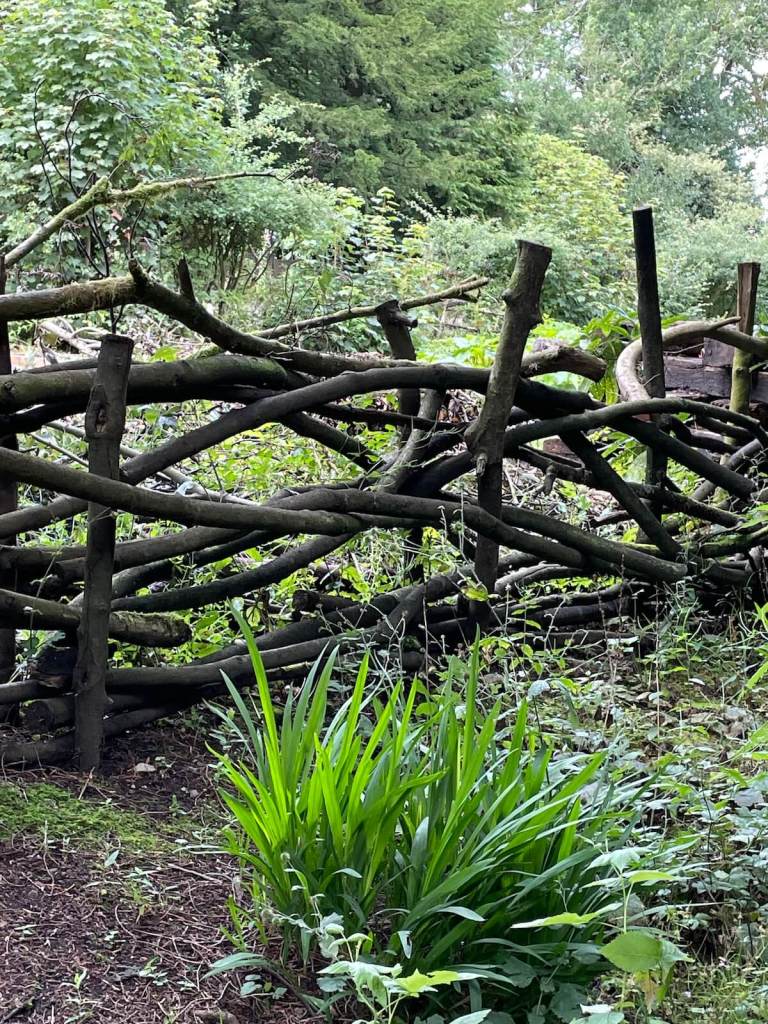
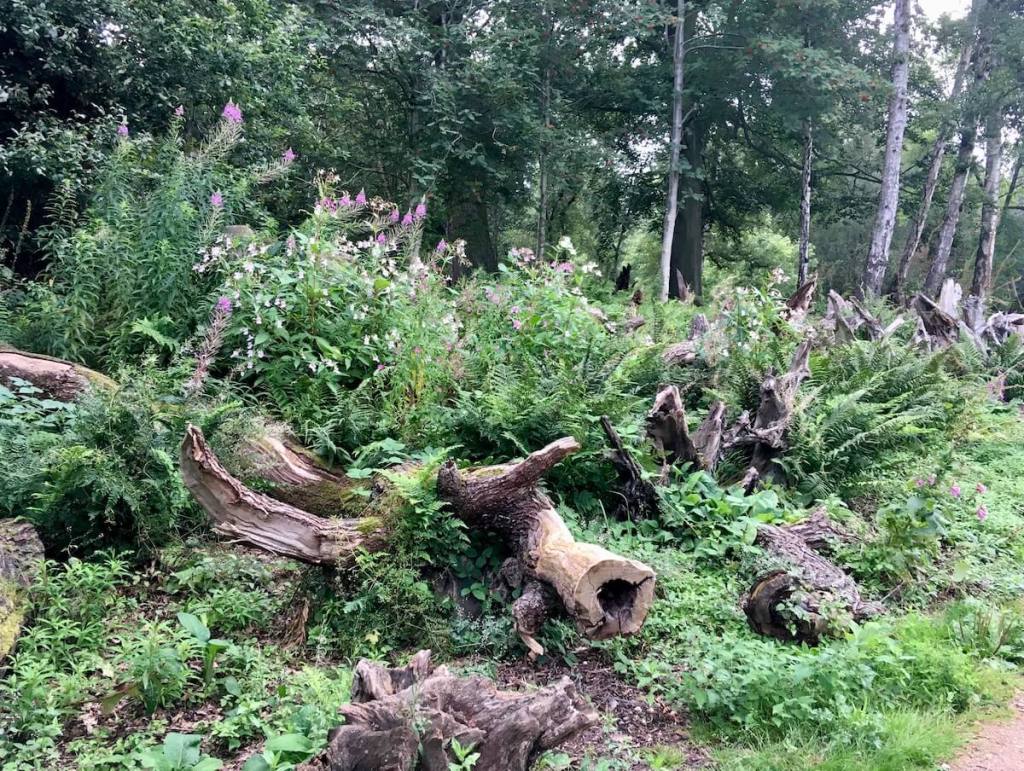
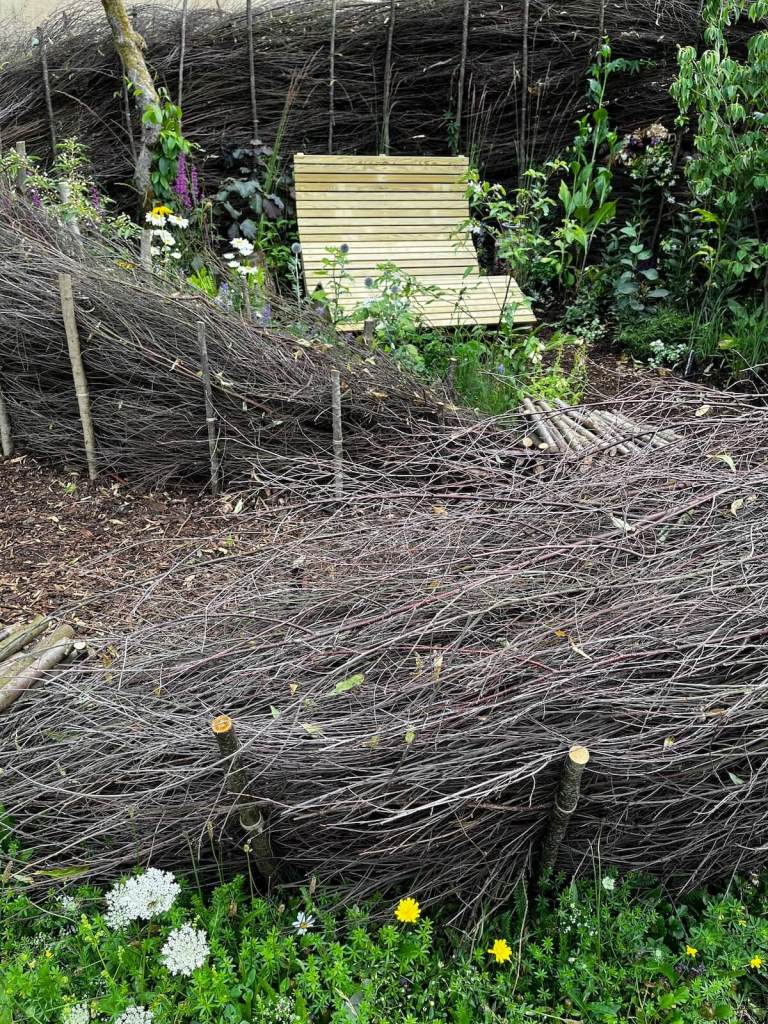
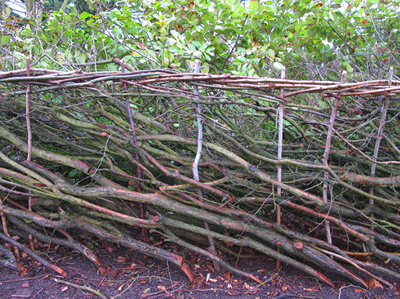
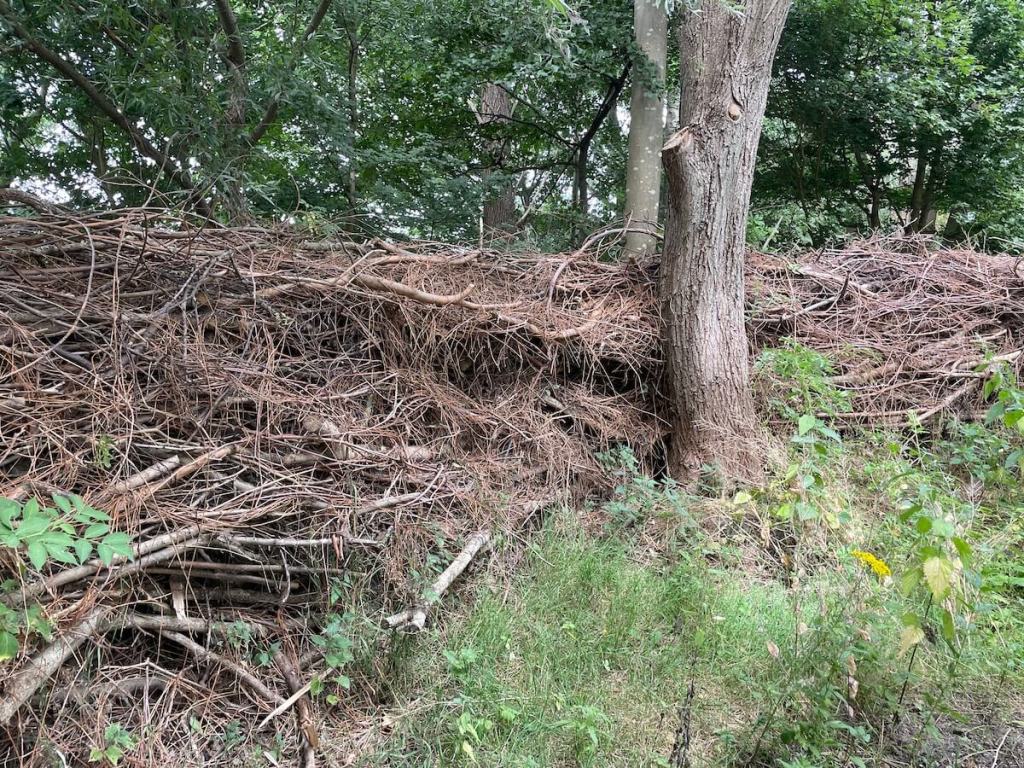
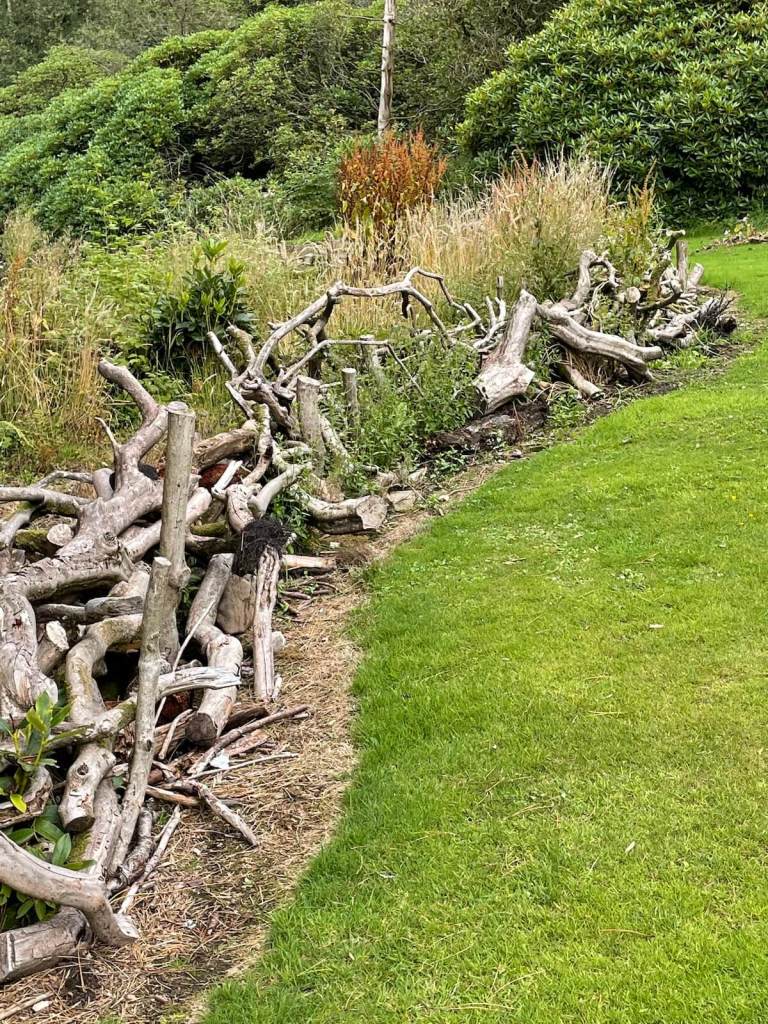
Note: Another creative use for stumps, logs, and limbs is the “stumpery” – click here.


Southerners naturally gravitate outdoors as often as possible, easily finding sociable gathering places – front yard or back – where we can temporarily escape the dinner dishes and TV. Where we laugh about everyone who isn’t here, and during conversational lulls someone inevitably mentions cicadas or four o’clocks. And of course it usually includes cooking, with languorous fans keeping ‘skeeters at bay.
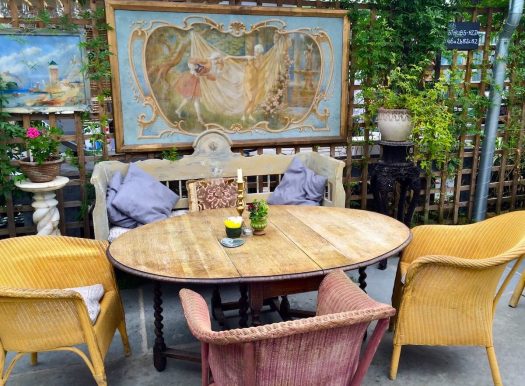
But without a place to sit, where you GONNA? Nobody does it for long without a comfy place to set our tired bones.
Outdoor seating goes way beyond merely enticing us outside in the first place, where senses can kick in, where we notice stuff, from hearing birds and evening frogs, take in heady scents from flowers and fresh-mowed lawns, savor the occasional faint breeze, and enjoy a cool beverage while watching the inexplicable stormless flicker of “heat” lightning.
Read more: Garden Seating – Where It All Happens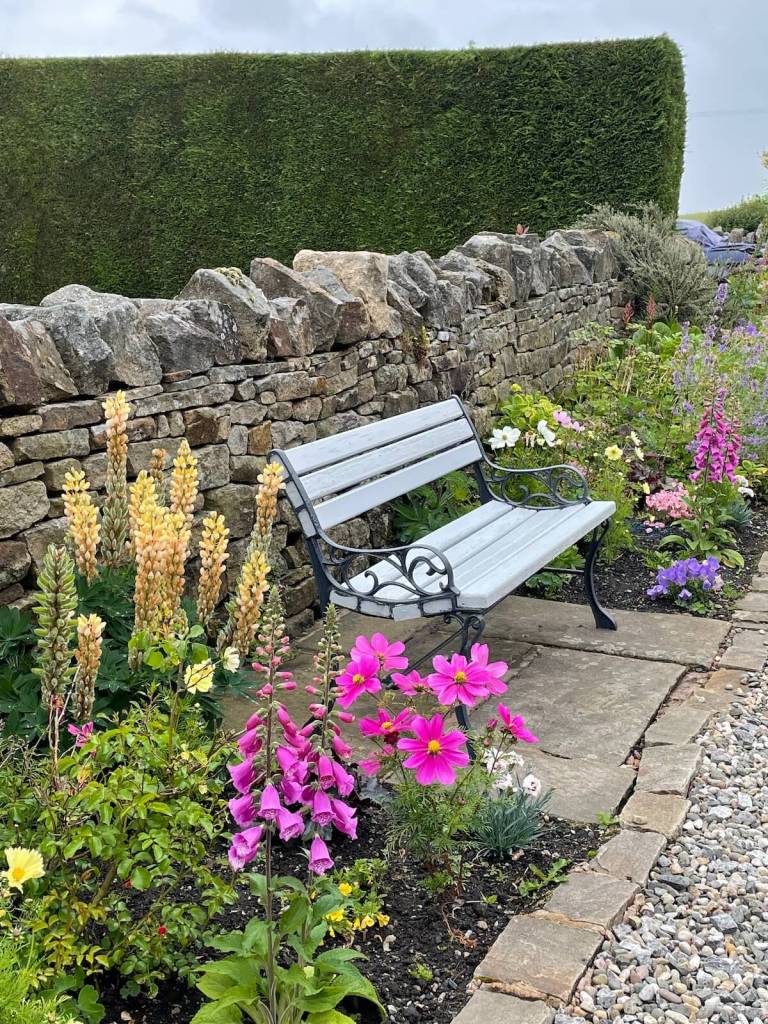
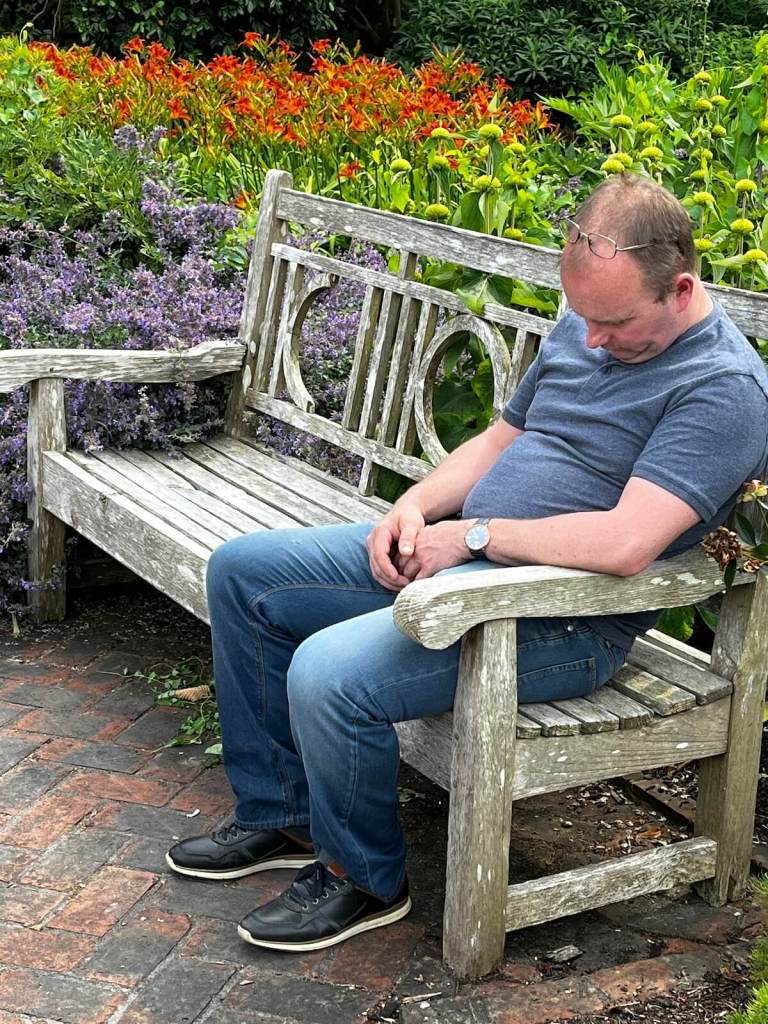

We’ve sat on everything, from carved logs to contemporary materials and otherworldly designs. We’ve tried out antique teak Lutyens benches, intricate wrought iron combos, colorful 1940s clamshell-shaped pressed metal chairs (and gliders, of course), uncomfortable Adirondack chairs, inexpensive nylon mesh that leaves back-of-thigh marks, and all sorts of other material ranging from inexpensive plastic and durable composites to car tires, bamboo, wicker, and all kinds of wood. With or without weatherproof cushions.

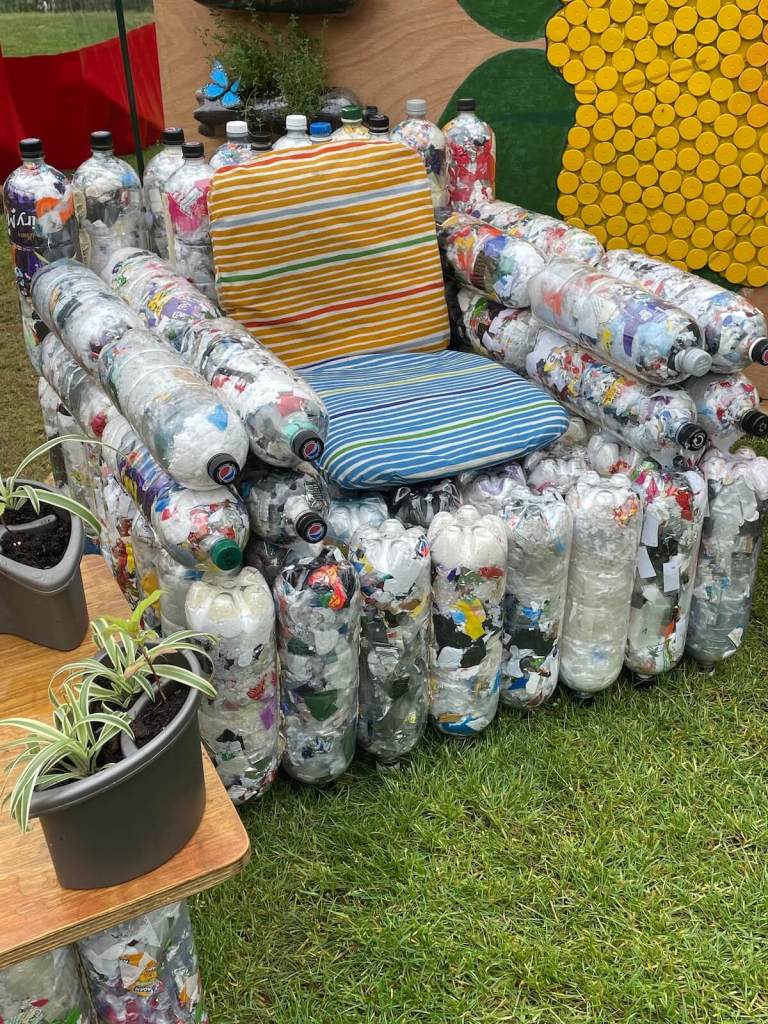





Anyway, garden seating is too often added as a mere accessory, even going beyond comfort. As a friend once wrote, “Times change, people change, but, like the porch swing, there are some things that just need to be brought forward into the present. Both to recreate the peace they brought us in our younger days, and to share this peaceful pastime with those who never experienced it so they can grow some memories too.”

For me, it ain’t a garden without a reasonably pleasant place for ruminating and reminiscing, hopefully, as country crooner John Anderson sang, “feeling love down to our toes, just a swangin’…”
Speaking of which, my own garden swing is hugely enhanced by having a long chain coupled with a pair of “swing springs” which reallly put the bounce in things… for more on this, click here.
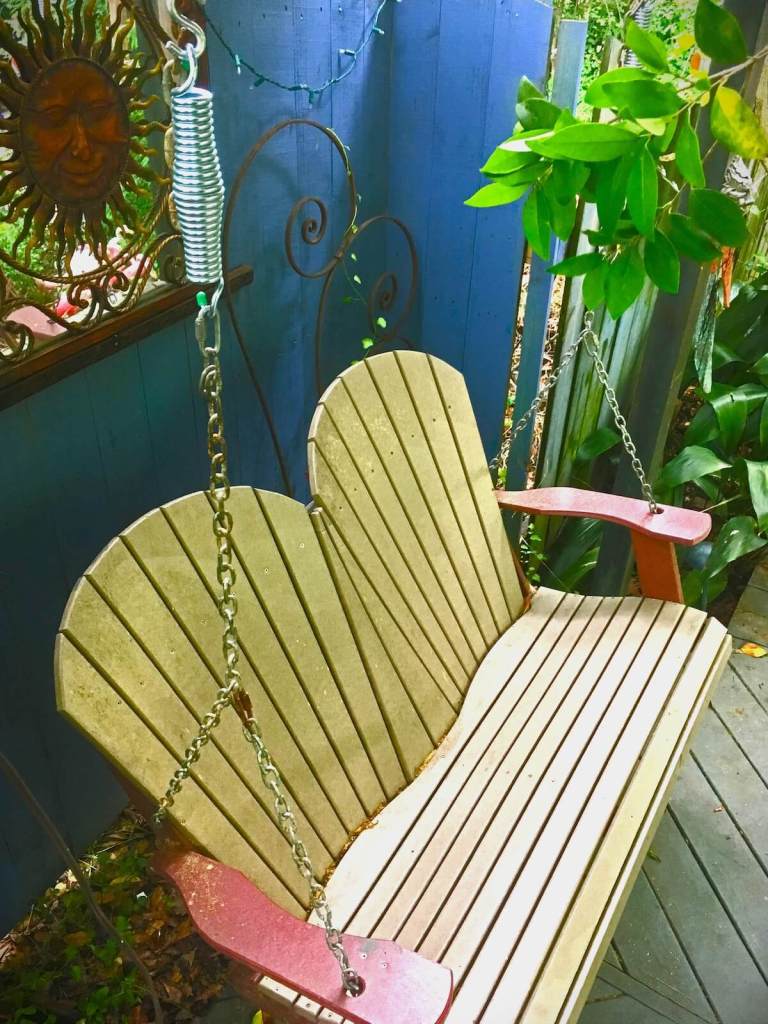
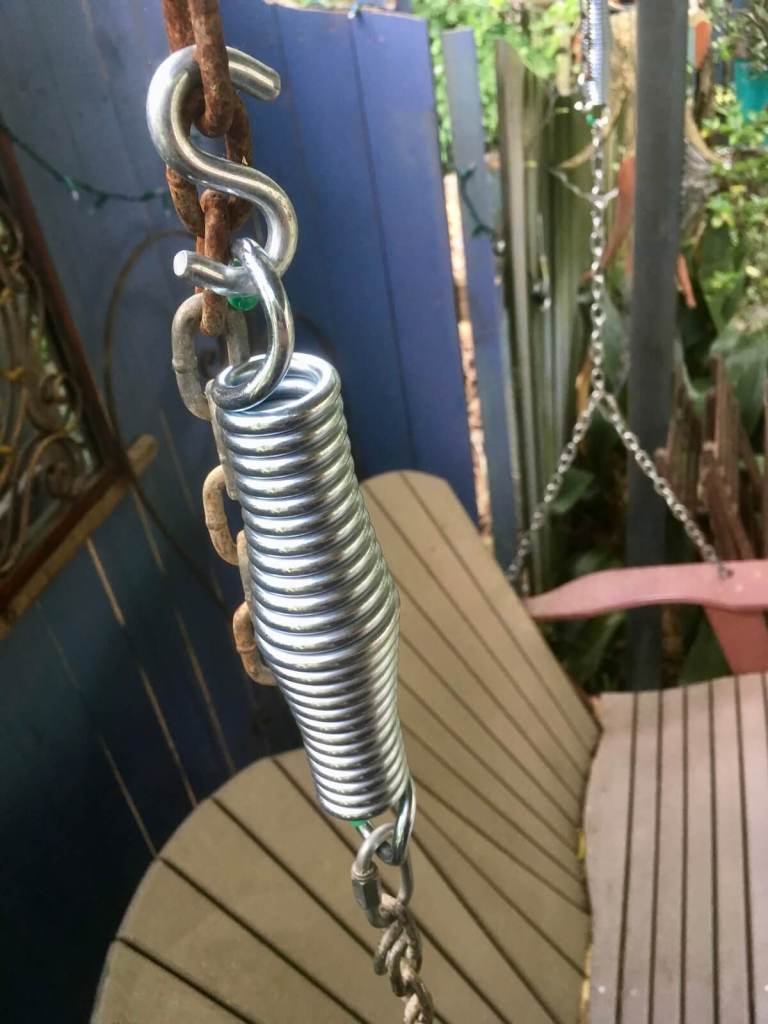

Here are a few examples of garden seats I have seen around the country and beyond, all which have one thing in common: Outdoor relaxation. Enjoy!
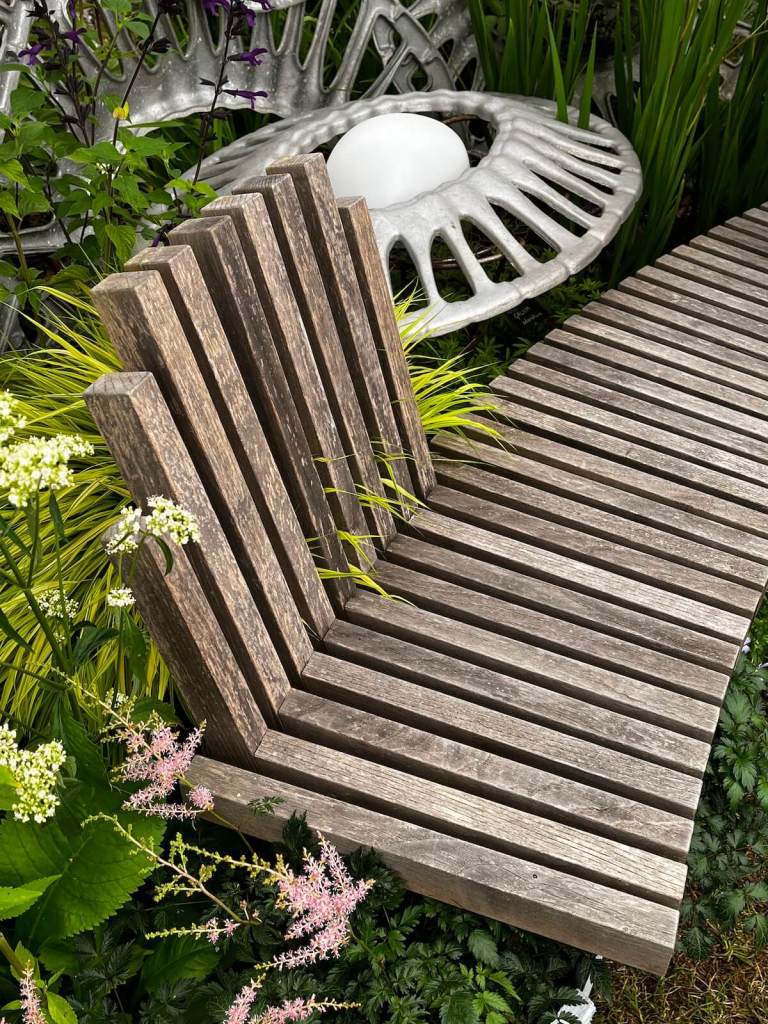


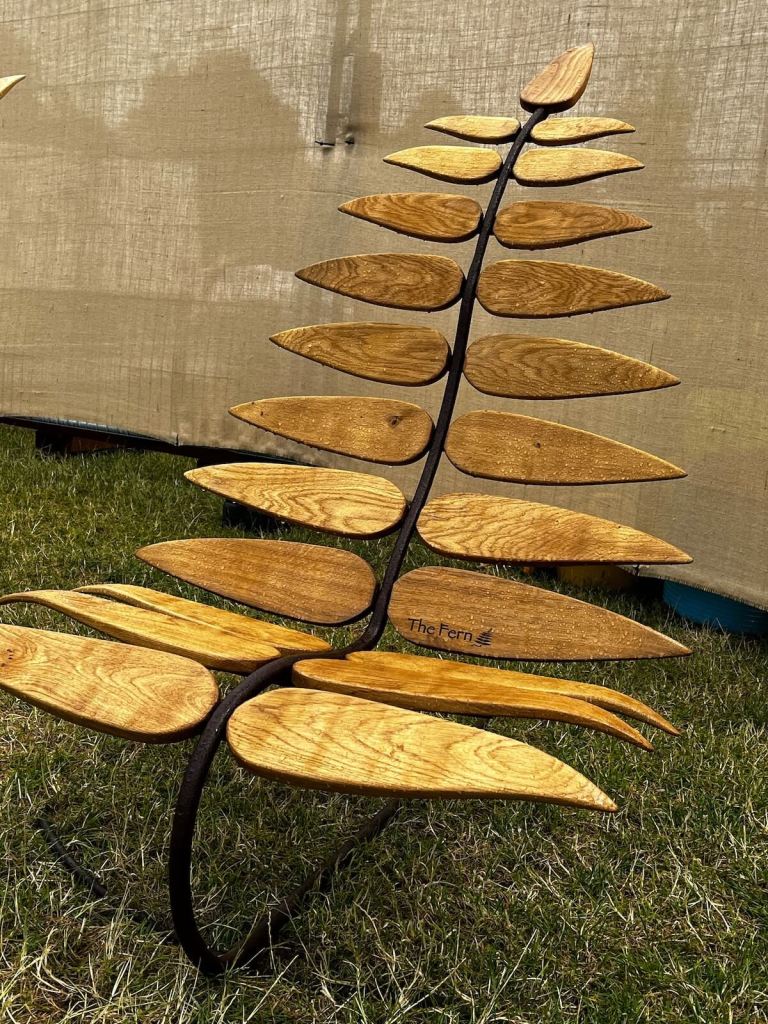

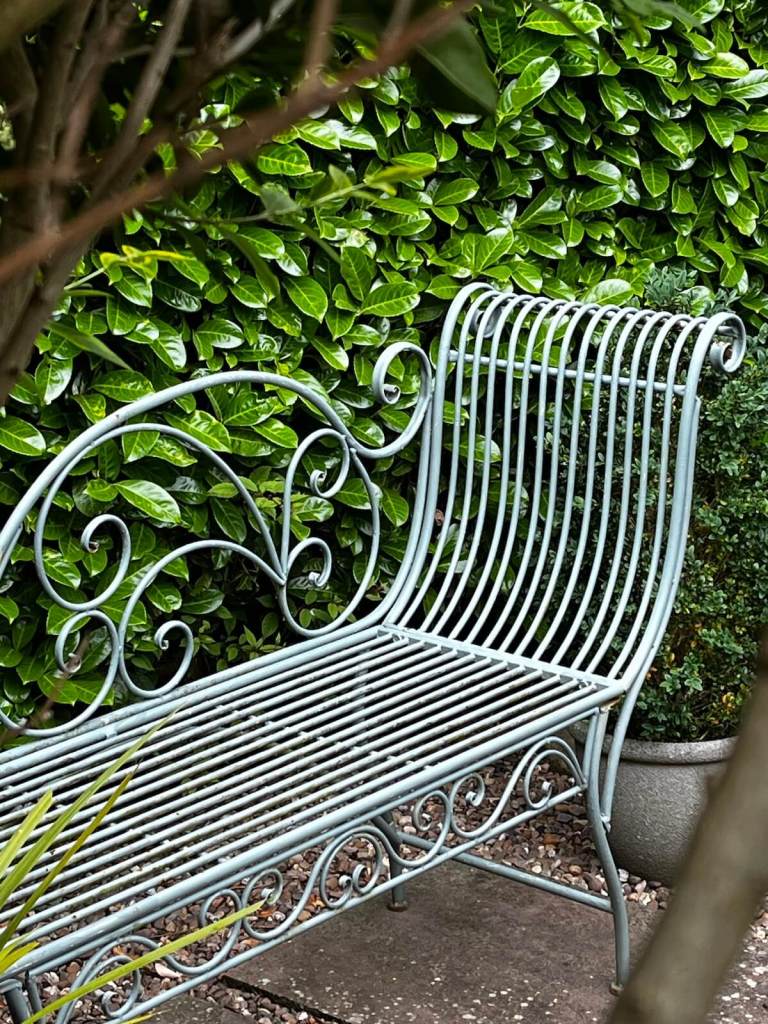

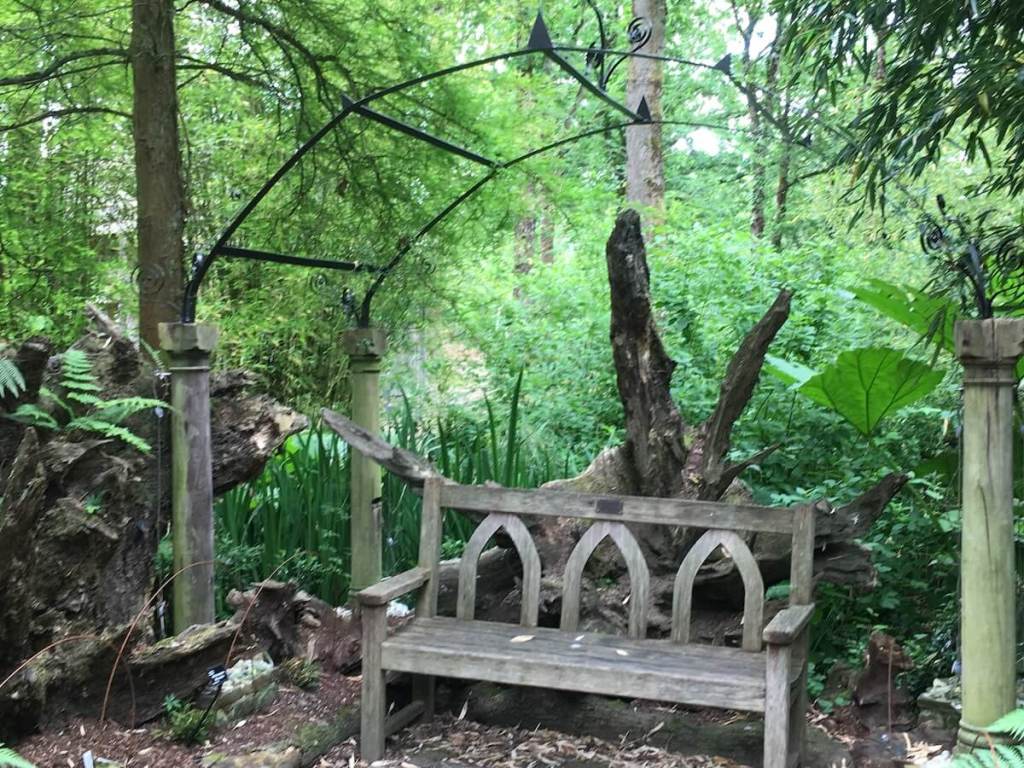


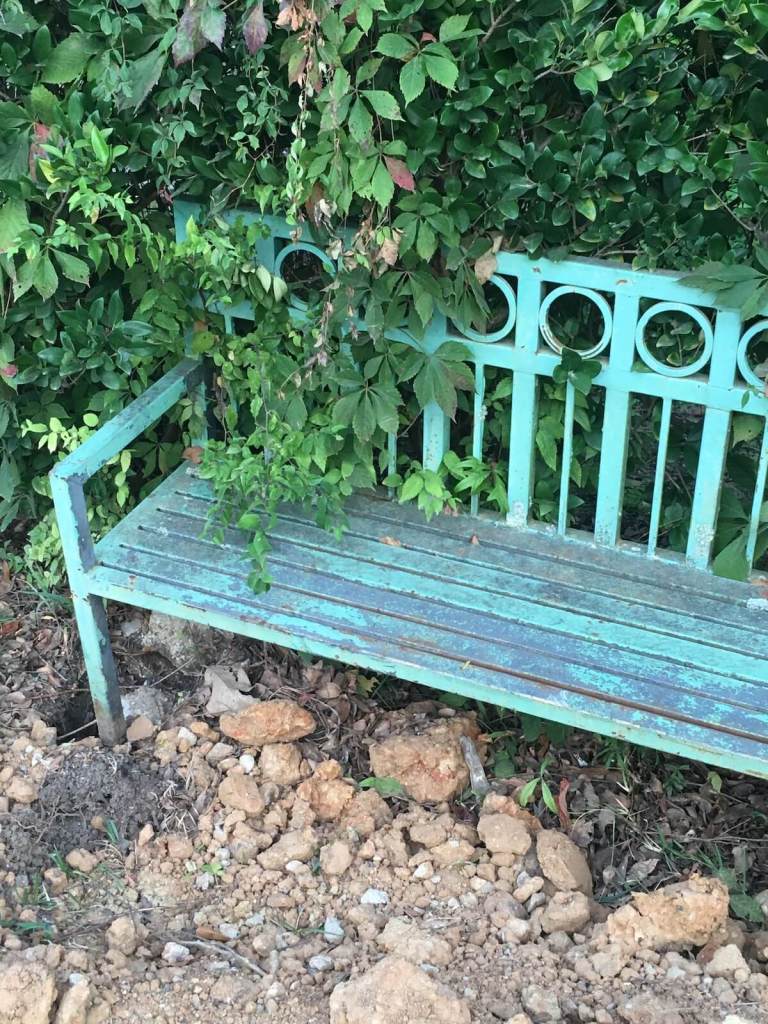
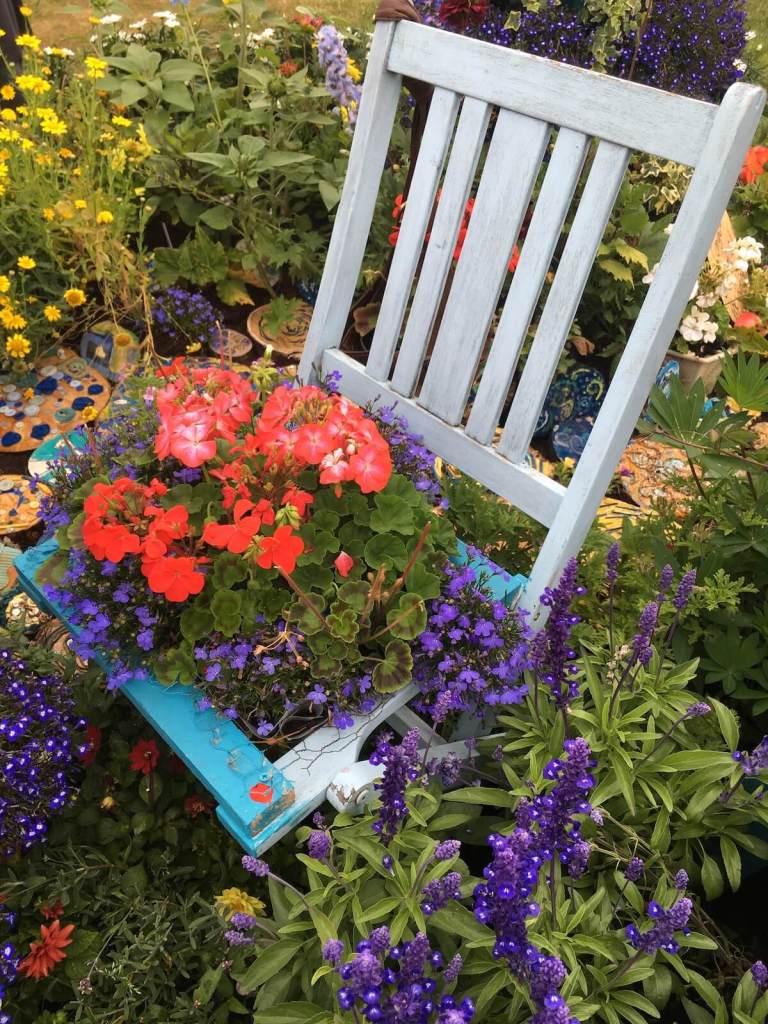
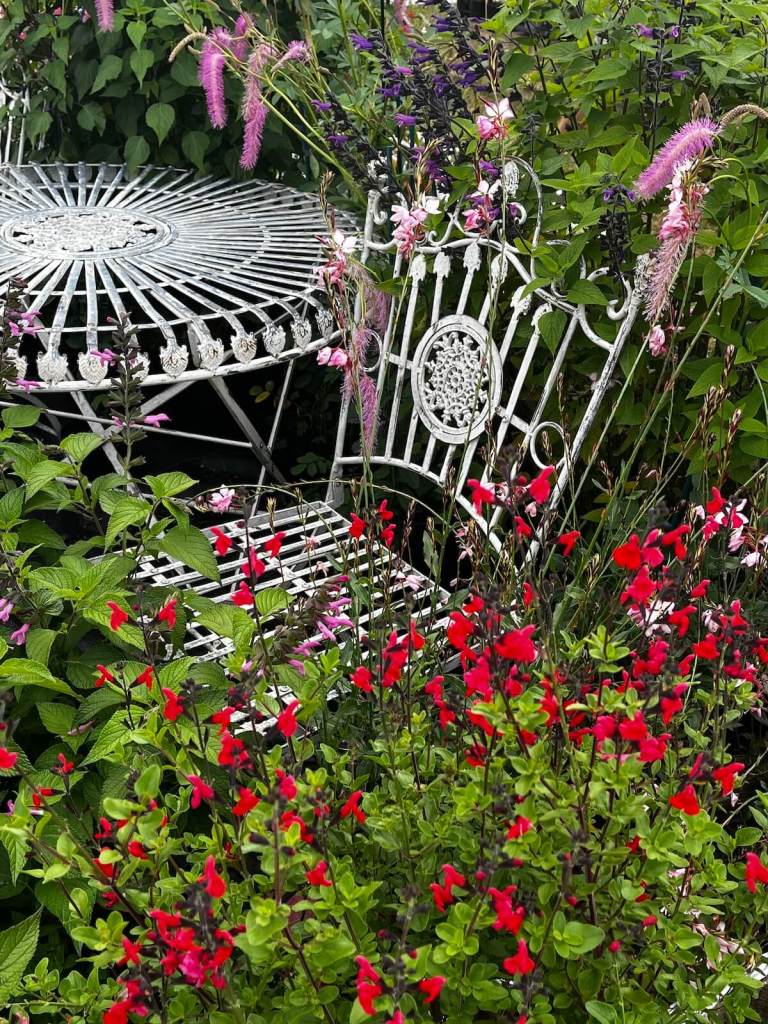
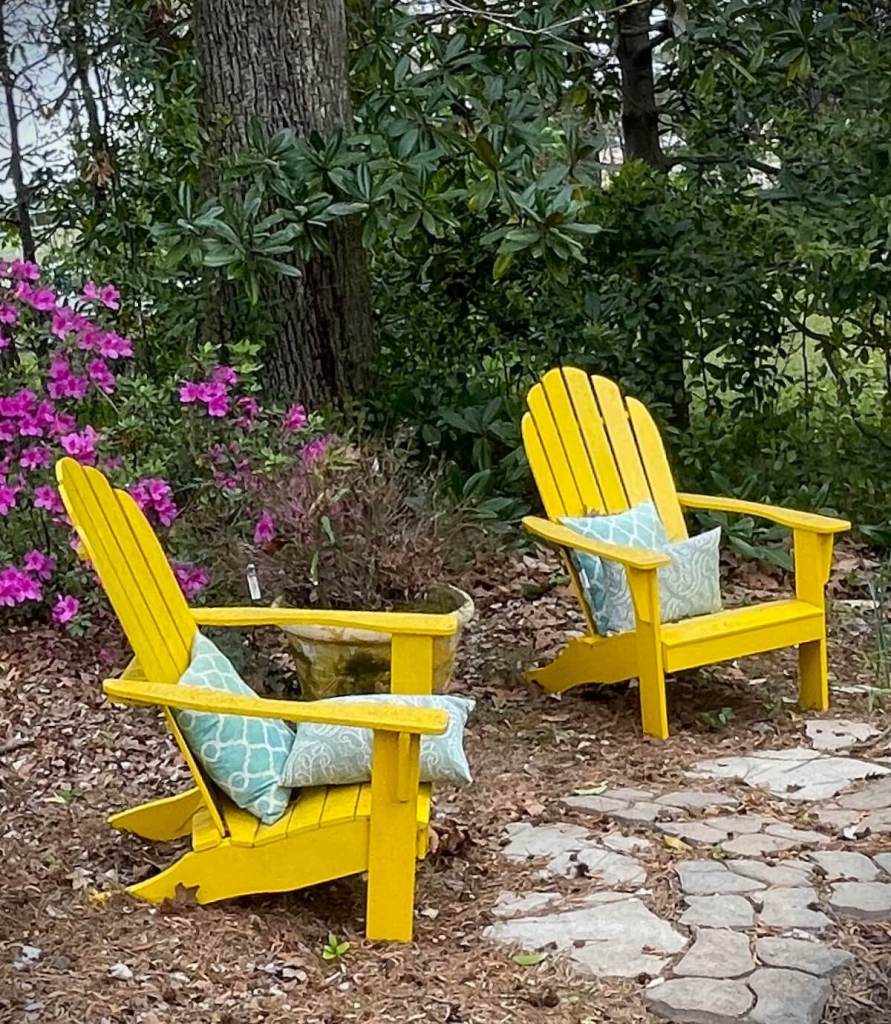
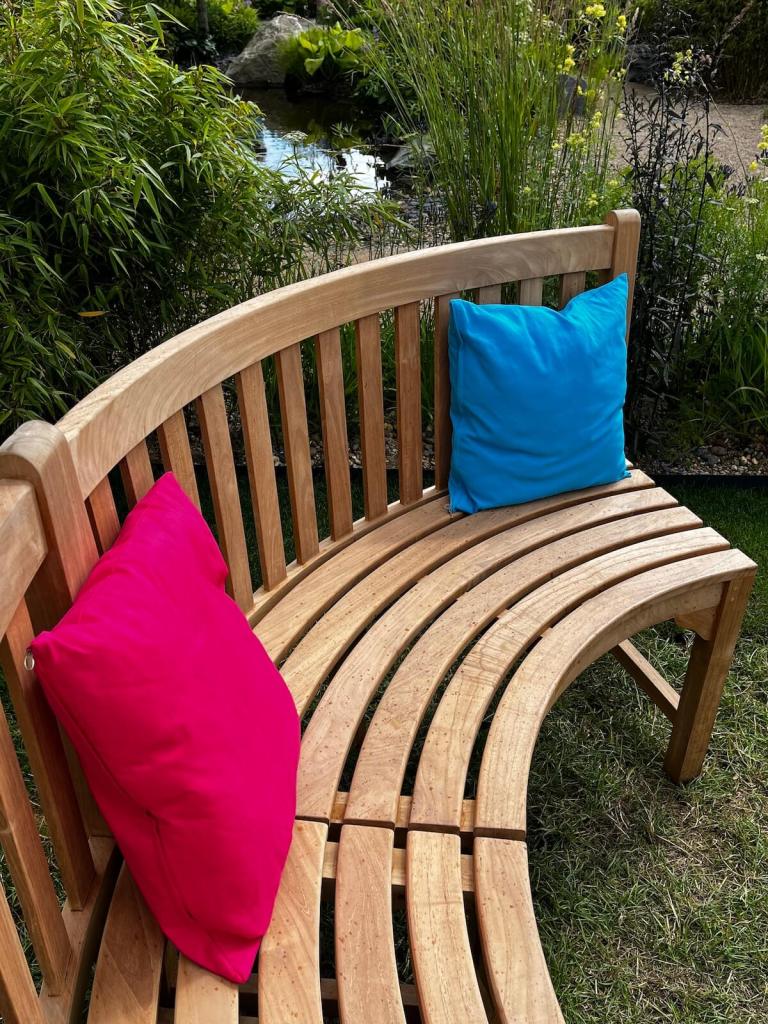
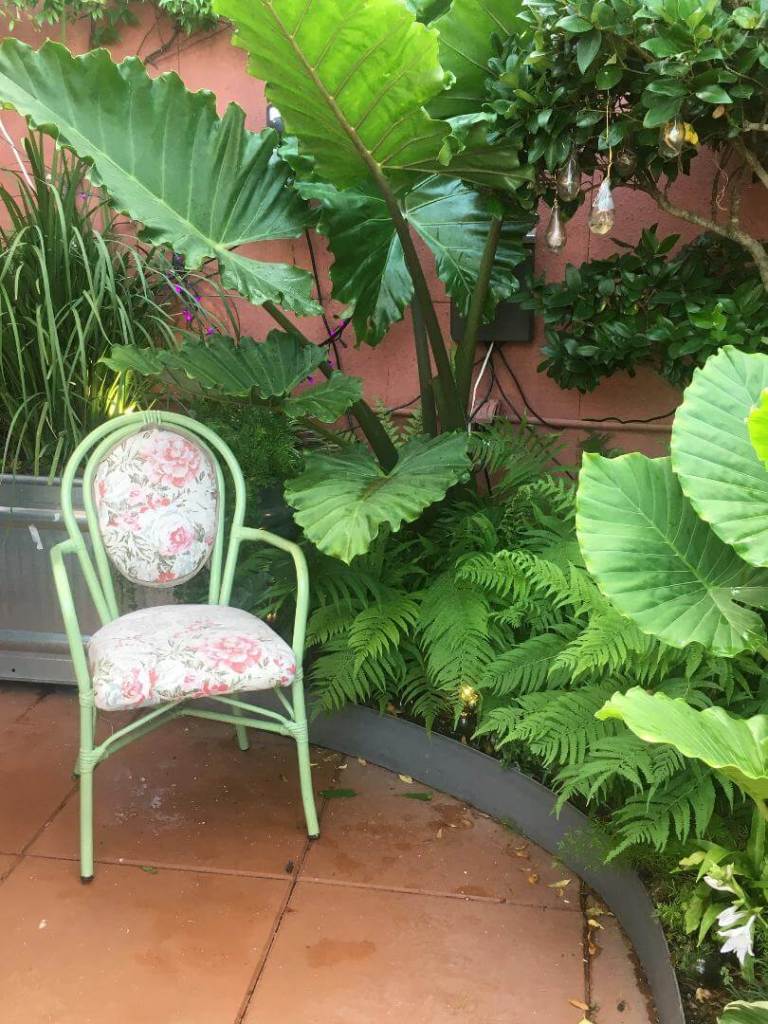

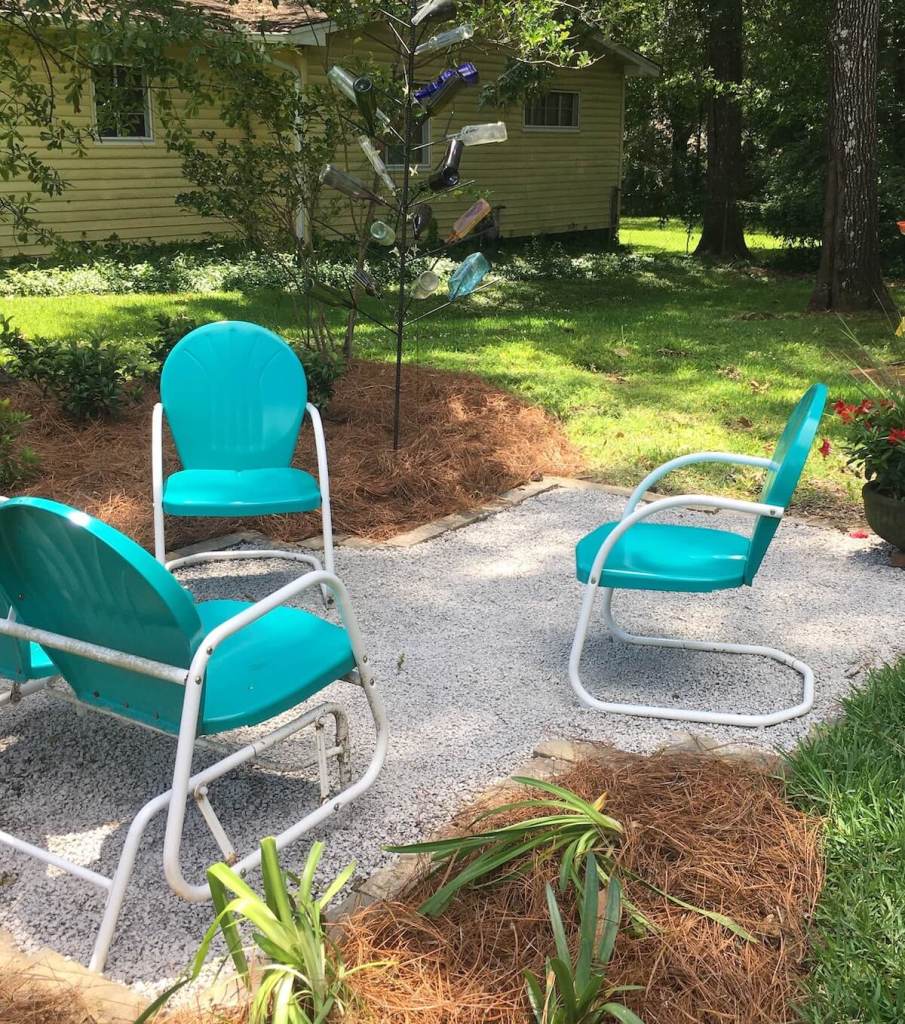

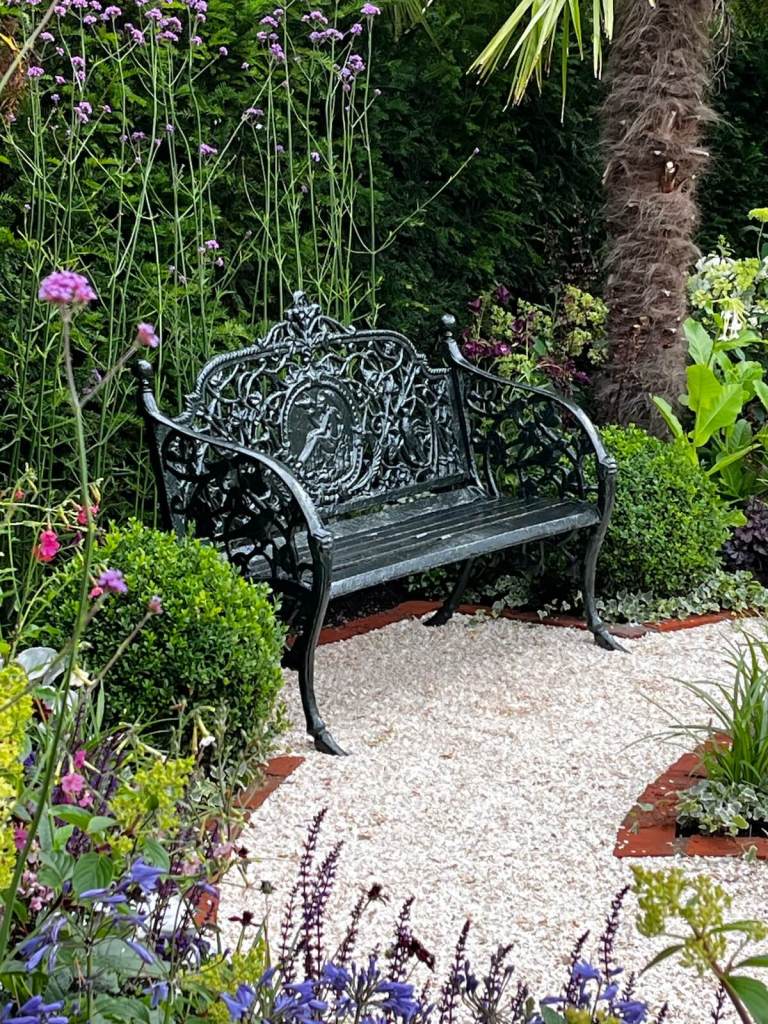
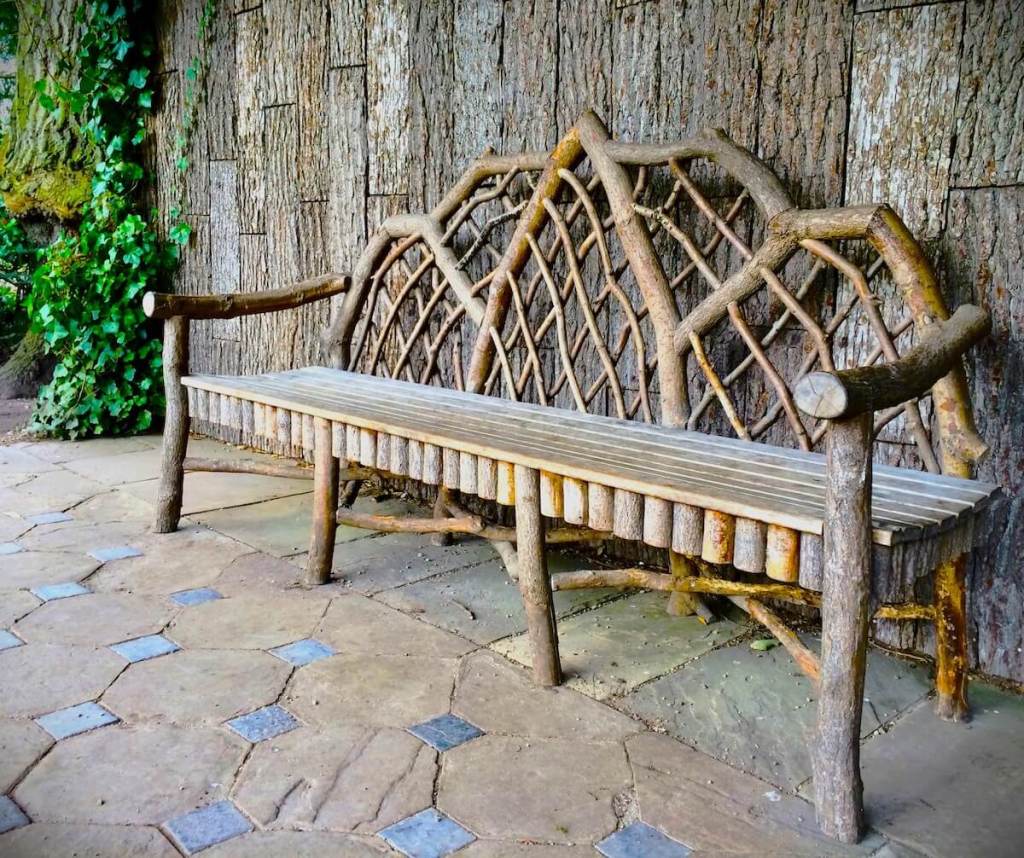
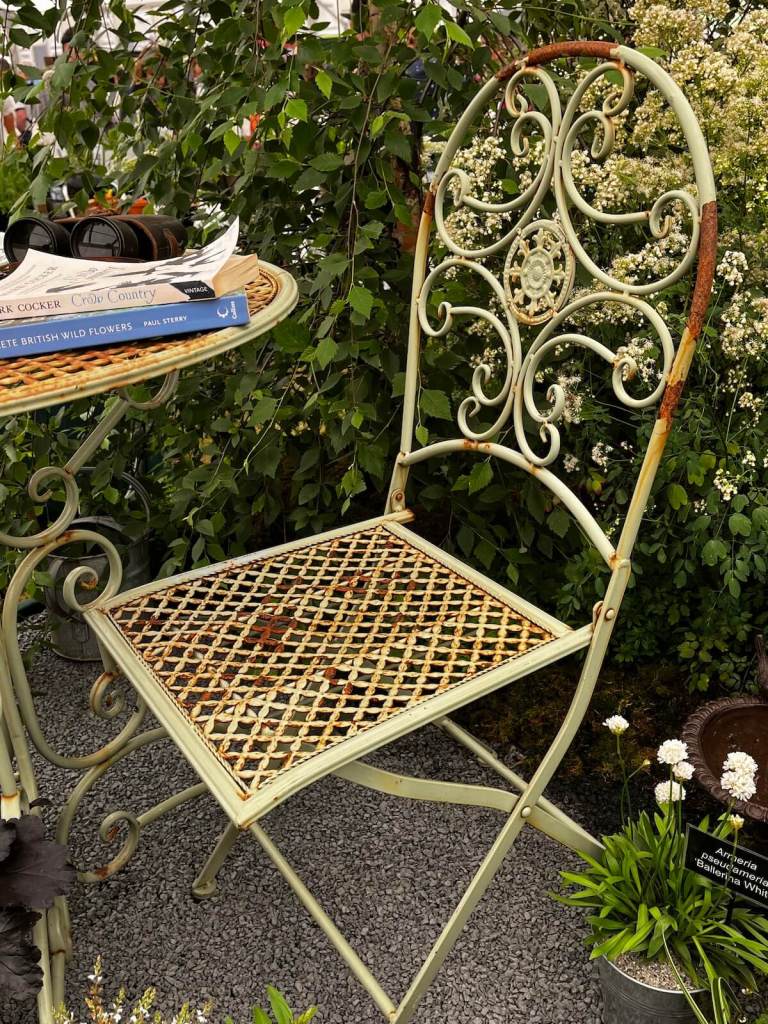

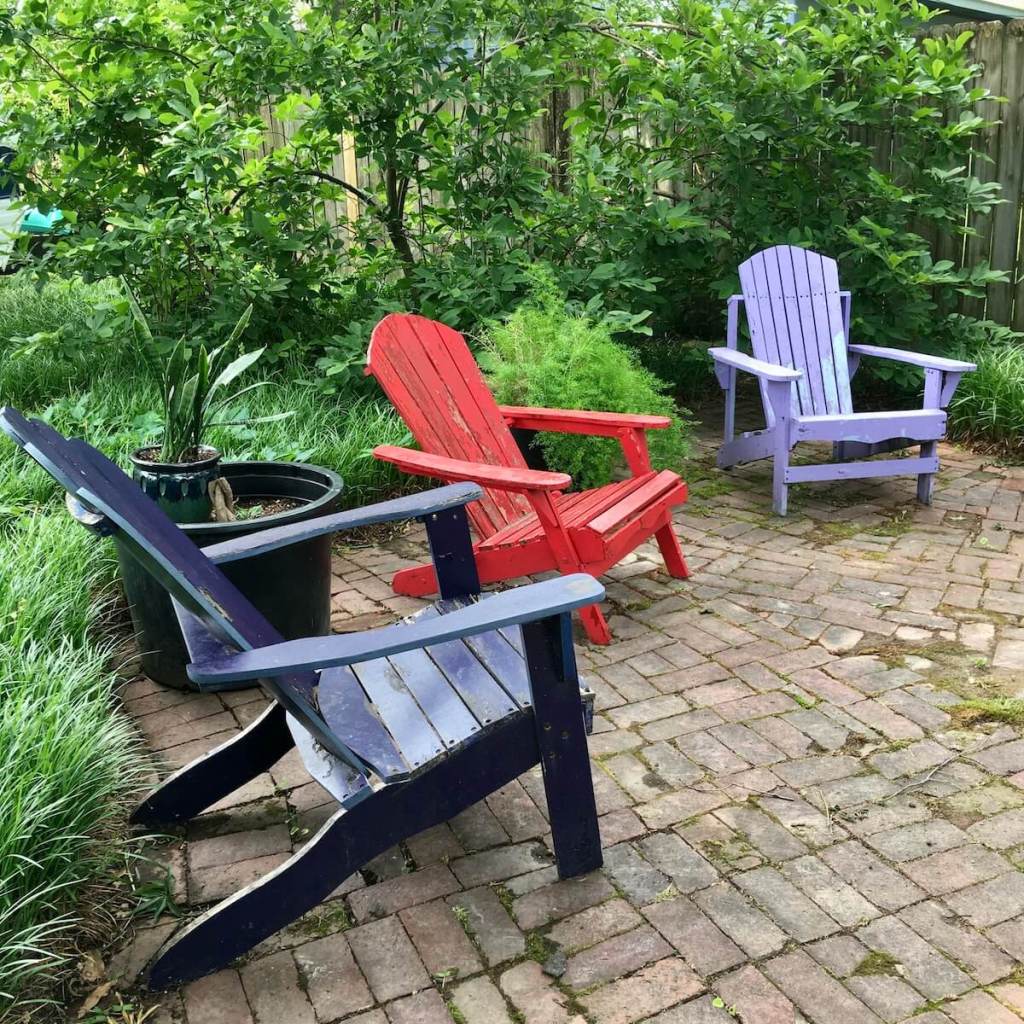

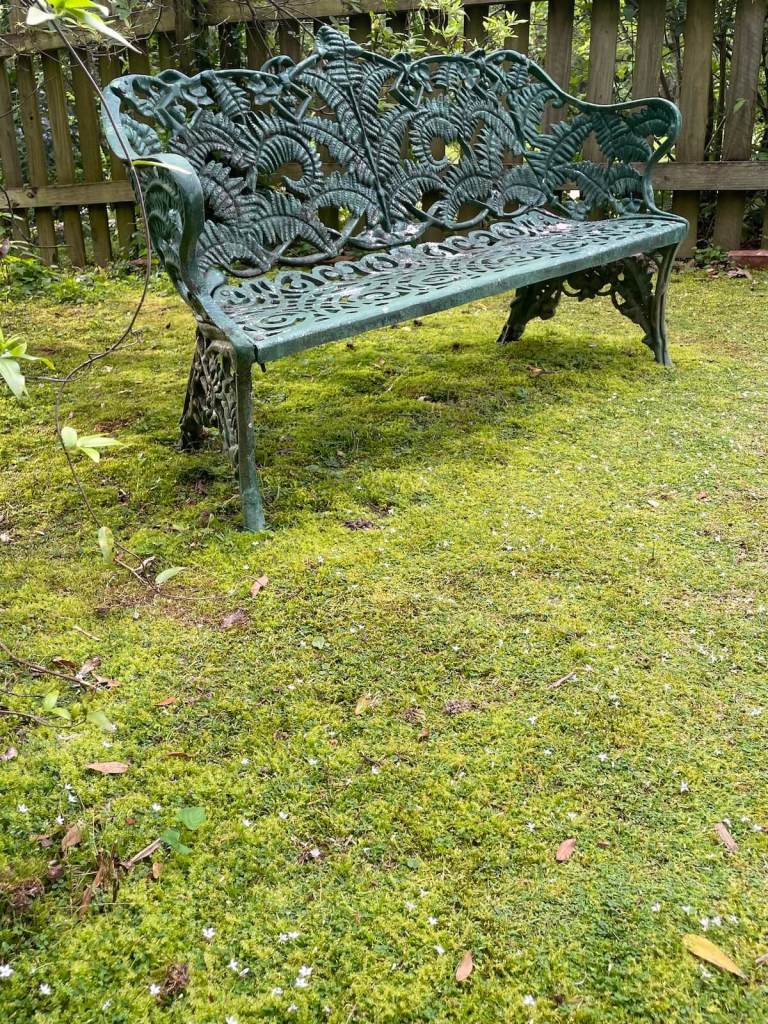




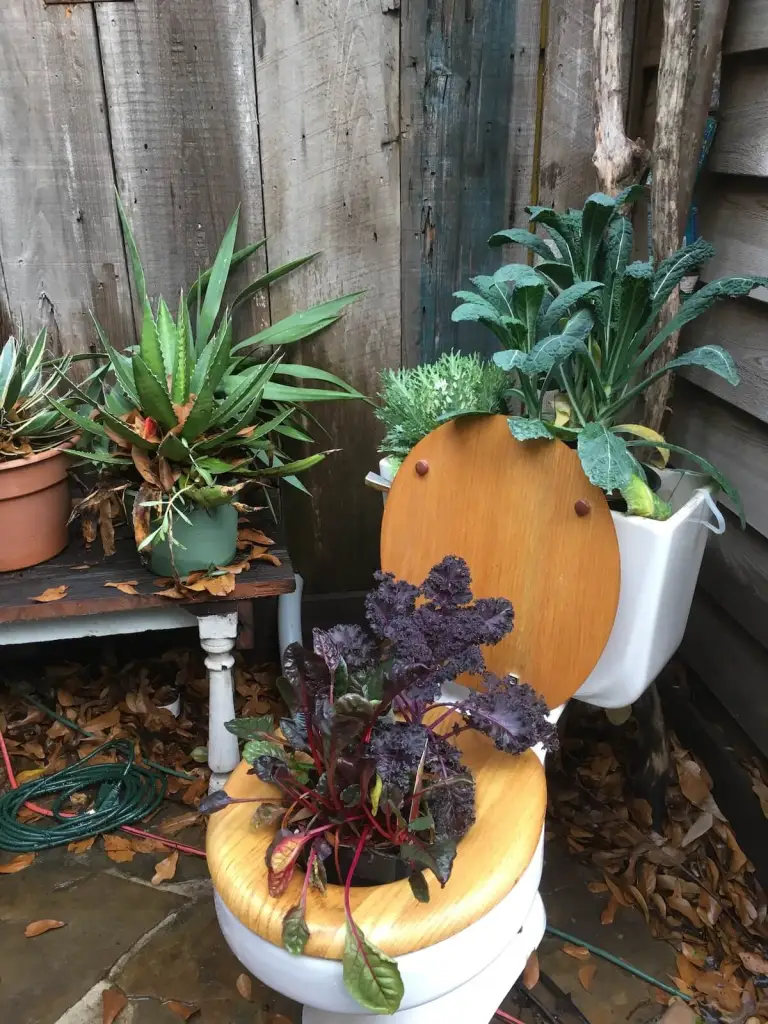
Sorry about the poor quality of this photo, taken from an old print photo made before digital cameras, but here are my long-gone front deck chairs I got in Mexico, made from bicycle and motorcycle tires…


Surprise Encounter: When my kids were very young, longtime horticulture friend Bob Brzuszek took us out into a Mississippi bog to show us wild pitcher plants (Sarracenia), carnivorous plants which get their nutrients from dissolved insect prey trapped in tall, hollow, water-filled leaves.

In a shocking real-life case of deus ex machina, as Bob sliced open one of the colorful funnels to reveal the partly-digested insects inside, a recently-ensnared honeybee flew out, released from the grisly death trap.
That came rushing back to me the other day when my sweetheart and her sister and I, looking for a rare colony of naturalized pitcher plants, were out “bog yomping” which is what locals around my summer home in northern England call hopping from tufts of grass to keep from getting muddy while traversing the remote moors.
Fens and Bog People
The misty moors of Lancashire are steep and windswept, nearly treeless except in the deep waterfall-fed ravines; the hillsides are covered with grasses and sedges, and rife with shallow pools gouged out by ancient glaciers, now matted with deep blankets of sphagnum moss, wildflowers, pink-and-purple heathers and thickets of sweet blue wimberries, tart blackberries, and succulent raspberries.

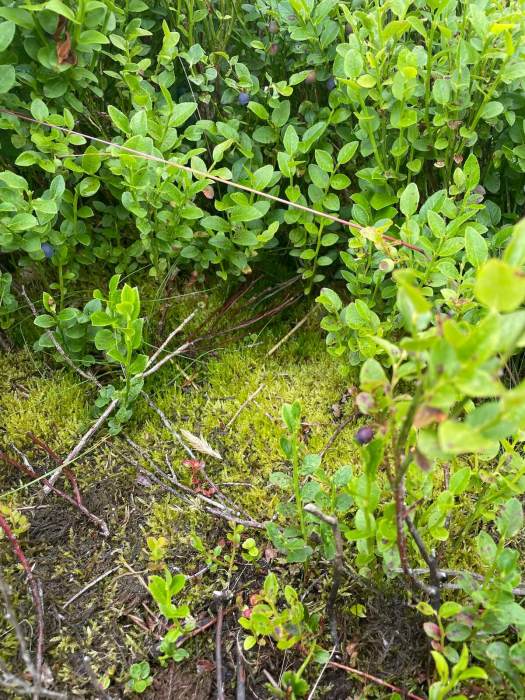


This is my fourth Floriade experience, attending the world’s largest horticultural exhibition, hosted in The Netherlands just once every ten years. This year’s show, as in the others in 2002 and 2012, featured stunning garden designs from dozens of countries around the world, exciting plants, unique accessories, garden art and other “hard” features, and the latest/futuristic horticultural innovations. With universal themes of sustainability and connections to nature, I took notes on dozens of ideas I can use in my own little cottage-style garden.

An exercise in Occam’s Razor (the K.I.S.S. approach)
Bottle trees, beyond their being folksy “make-do” garden ornaments, are a proud form of recycling. I’ve met hundreds of folks who openly confess they are “saving bottles” for a notional future state of nirvana they hope to reach when they’ll feel daring enough to actually put a bottle tree in their garden. Where used bottles belong.

In these weird times, bottle trees strike a chord for being a simple, refreshing, liberating aspect of life where there are no rules at all about getting it right or wrong. Unlike same old, same old pink flamingoes, no two bottle trees look exactly alike, not even those made of standard welded frames bedecked with your personal choice and placement of bottles. So, without a standard to go by, you actually can’t mess up.
Continue reading “How to Make a Bottle Tree”Glass “bottle trees” have been around for centuries, first as icons of superstitious beliefs based on a three-thousand year old Arabian folk tale, and now increasingly as eccentric but popular home-made glass garden ornaments. I know these folksy sculptures aren’t every one’s cup of tea, but there are thousands of them scattered across gardens of a surprising assortment of people; I’ve photographed them in modest home gardens to upscale botanical gardens and art museums, rarely with any two being exactly alike – the only things the widely diverse gardeners who create or display them have in common are glass bottles held up where the sunshine can radiate through them.
Some wet blankets sniff that these folksy paeans to stained glass are forgettable sights, which to me means they just don’t get it, and that’s okay – I mean, not everyone hangs glittery stuff from holes in their ears, either, right?
Though Eudora Welty photographed a bottle tree in the 1930s, the first authentic glass bottle tree I can recall was beside a tenant shack on a dusty road dead center in the Mississippi Delta. I was maybe fifteen, yet to this day the inexplicable spectacle haunts my sense of the absurd.


Can’t get away from Mississippi ditchbank weeds – even in England (where they seem to be better appreciated)!

But truth is, just as we yearn for stuff from afar, Southeastern U.S. native flowers are wildly popular in most upscale English gardens – used “as if they are normal plants” – with the best being those accessorized with natural or rustic elements.
Continue reading “Mississippi Wildflowers in England”As a “person of curiosity,” I’m easily thrown off course when little garden events prompt questions.
On summer evenings in my youth, I was sometimes encouraged to sit on the porch with grownups, to be mesmerized on rare occasions as my great-grandmother’s treasured heirloom “night blooming Cereus” unfurled its large, exotic, fragrant evening flowers. Now that’s a way to hook kids on the mysteries of the garden! And I was also shown some of the creatures that billowed or crept out of the shrubs at night to pollinate those flowers, or to hunt the pollinators.

Anyway, one recent sultry summer evening, watching evening primrose flowers open at dusk and basking in the heady bouquet of four o’clocks in the still night air should have been soothing to my creative right brain. Instead, the interwoven dance of flowers, fragrance, and large, hovering sphinx moths flitting around between newly-opened flowers and avoiding voracious night-feeding geckos, kicked my analytical left brain into overdrive.



One of my so-far unanswered question is, what makes some plants flower at night? In addition to the primrose and four o’clocks, other of my garden’s evening flowers are moonflower vine, angel trumpets (both Datura and Brugmansia) and a scraggly night-blooming cereus (Epiphyllum) grown from a cutting from my great-grandmother; there are more, of course, in gardens of others, plus many daytime flowers that remain open all night (Cleome comes to mind).



Truth is, we still don’t know why they open at night. Best theories are that over thousands of years some plants have adapted techniques for avoiding moisture loss in hot, dry climates; and that some evolved light-colored, fragrant blossoms which open late to attract shy pollinators that venture out at night to avoid predators that are less aggressive in the darkness. Except for those insatiable, lightening-fast geckos, of course, which by the way have gotten rid of ALL the roaches that used to frequent my back garden.

Anyway, while jonesing for explanations to these minor mysteries, I pored over my faded plant physiology class notes, trying to rewrap my old head around long-forgotten technical concepts.

Not to get too technical here, but plants have light sensors, called phytochromes – biological switches that turn night/day responses on and off. Full sun exposes phytochromes to lots of visible red light, which energizes plants into active growth mode; shaded or late afternoon sun has more far-red wavelengths, which tell plants it’s time to transition into night mode.
Here’s how plants tell time: Certain compounds produced during daylight hours break down slowly overnight, enabling plants to chemically “know” how many hours they spend in darkness; yeah, plants tell time by hours of darkness, not hours of daylight. Plus, as nights get successively shorter or longer, plants keep track of this stored information to gradually prepare for changes needed in approaching seasons. Horticulturists take advantage of this by using extra lighting or shading to trick poinsettias, Easter lilies, chrysanthemums, and other holiday flowers to bloom out of season.
The physics are interesting as well: Different stimuli, including temperature and humidity, trigger plants into pressurizing fluids that move into or out of “hinge cells” at the base of leaves and flowers, causing them to get bigger or smaller, longer or shorter. This is what crank flowers to open and close, leaves of some plants to fold and unfold, and stems to bend towards light.
Ah, I can go on and on until our ears start to bleed. I just think that science is so grand! Helps me sort out what’s happening, if not why. But I’ve got to relax now, try to get back to just soaking in the evening garden’s natural sensory allures.
(Sitting on the porch swing, I hear someone murmur “Don’t those four o’clocks smell nice?”)


Turns out, it’s a literal thing that “You can take the man out of the garden, but you can’t take the garden out of the man.”
My spot-on sweetheart has commented many times about how this “mucky pup” of hers loves little more than just digging in the dirt. Not necessarily planting anything, just… digging. Truth is, I have a nearly atavistic urge to turn soil over and over, beyond the expected satisfactions: it’s part of me, from how through decades of gardening I’ve slurped tons of unwashed berries, forgetfully chewed garden grime-crusted fingernails, and inhaled enough dust to start a raised bed.

In W H Auden’s In Praise of Limestone, the poet suggests that the physical characteristics of a place shape the essence of people who live there, often without their noticing the subtle sways. Having grown up during the innovative 1960s musical melting pot of Blues, Country, Rock & Roll and military bands, I have to tip my hat to Auden’s description of music as an encompassing influence which “can be made anywhere, is invisible, and does not smell.”
But unlike my beloved Mississippi Delta’s signature Blues music, the alluvial soil of my region, kicked up by ag machinery and blown by dust storms, can be sensed physically. It clogs our fingernails, stains our britches knees, billows and swirls up to create amazing sunsets and moonrises. And, right before approaching thunderstorms, we can easily smell its peculiar pong – that fresh rain’s coming fragrance.
One of the common smells produced ahead of thunderstorms is from ozone being released by lightening and other molecular schisms, which really is a thing. But ozone has a sharp smell, almost like chlorine, or an electrical fire, not the damp, earthy smell I’m thinking about.
The faintly sweet, earthy smell is caused by bacteria and fungi that create an oily substance called geosmin, which has a distinct musty odor most people can easily smell at low concentrations. It’s what gives plowed fields, compost, mushrooms, catfish, and warm lake water their faint earthy scents. And when big raindrops hit exposed dirt, or a low-pressure front ahead of a summer storm “degasses” the soil and pulls geosmin into the air, we inhale a compound of it called petrichor.
So, I’m thinking, if George Harrison’s (from Savoy Truffle) phrase “of what we eat, we are” can also apply to what we smell, then, yeah – in a way, my garden is not only in my heart and mind, but also coursing through my veins.
Gotta go. Dirt is in my hungry blood, and it’s calling me back to the garden.

Worth reading: Maverick Gardeners – New Book by Felder Rushing – Felder Rushing’s Blog